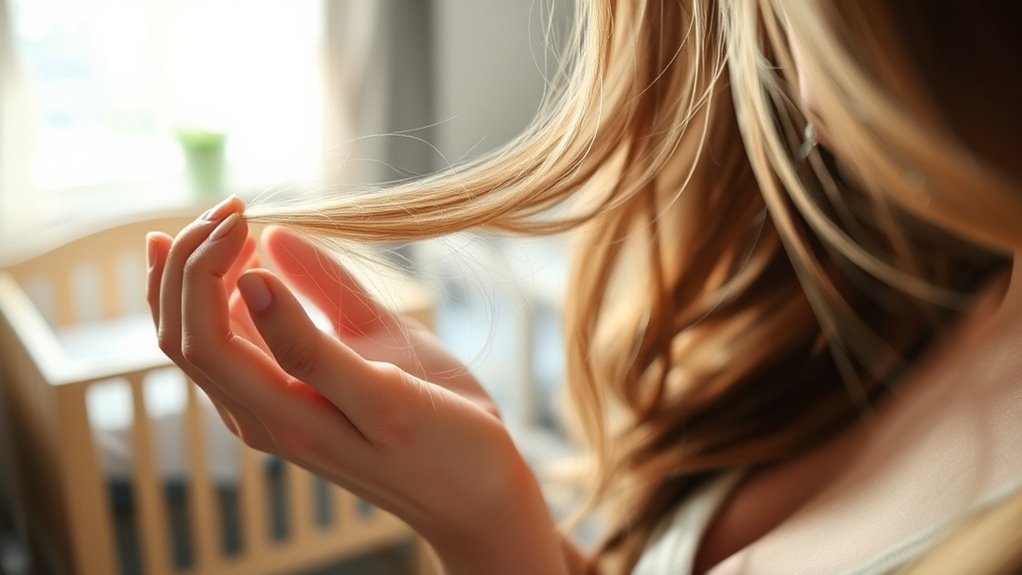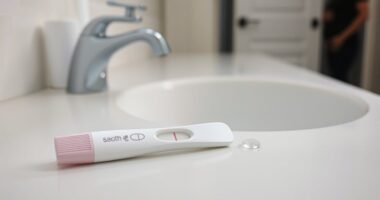Postpartum hair loss happens mainly due to hormonal changes after childbirth. When your estrogen levels drop, it triggers a condition called telogen effluvium, pushing many hair follicles into the shedding phase. You might notice increased shedding a few months after giving birth, peaking around four to five months postpartum. Don’t worry; this hair loss is temporary, and most women see regrowth within six to twelve months. There’s more to understand about recovery and maintaining hair health.
Key Takeaways
- Postpartum hair loss primarily occurs due to dramatic hormonal changes, particularly a drop in estrogen levels after childbirth.
- The condition is known as telogen effluvium, where follicles enter the shedding phase leading to increased hair loss.
- Hair shedding typically begins three to four months postpartum, peaking around four to five months after delivery.
- Nutritional deficiencies, such as low protein and iron, can exacerbate hair thinning during this period.
- Most women experience hair regrowth within six to twelve months as hormone levels stabilize and the hair growth cycle normalizes.
Understanding Postpartum Hair Loss

Understanding postpartum hair loss can feel overwhelming, especially when you notice more strands on your pillow or in the shower.
Postpartum hair loss can be distressing as you notice increased shedding after childbirth.
This common condition, known as telogen effluvium, affects about 40% to 50% of new mothers after childbirth. The primary cause is hormonal changes, particularly when estrogen levels drop after delivery. Emotional distress can also accompany this experience, as many mothers struggle with the changes in their appearance. Maintaining a healthy budget for self-care can also help alleviate some of the stress.
During pregnancy, higher estrogen levels keep hair in the growth phase, leading to thicker locks. After birth, the sudden shift triggers excessive shedding as hair shifts into the shedding phase of the hair growth cycle.
While this temporary hair loss can be distressing, most women experience hair regrowth and stabilization within six to twelve months. Additionally, fostering a digital-friendly environment at home can provide support and resources to help mothers cope during this challenging time.
Hormonal Changes and Their Impact
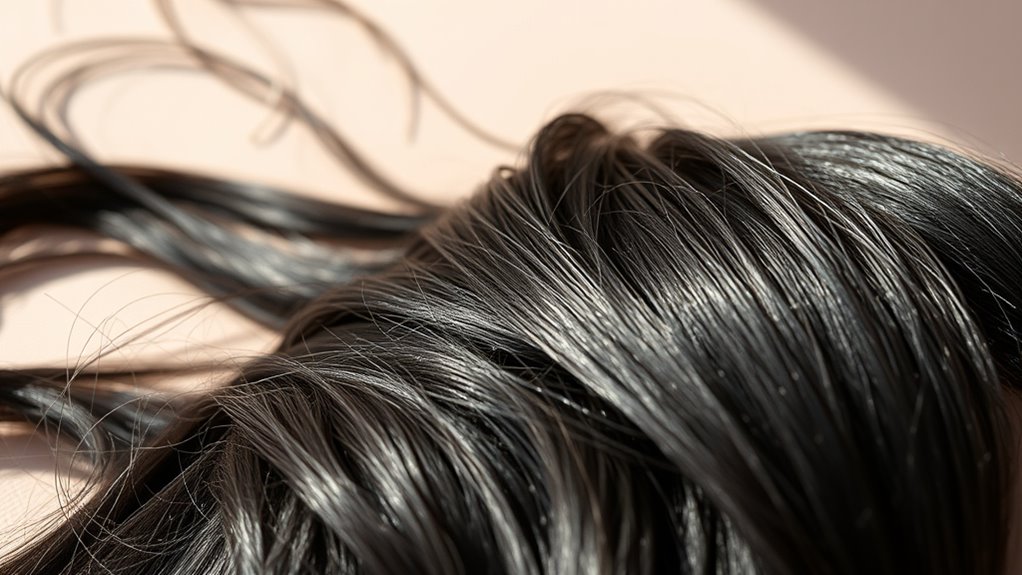
As your body adapts to the dramatic hormonal shifts after childbirth, you may notice how these changes impact your hair.
The significant drop in estrogen levels triggers postpartum hair loss, causing your hair to enter the shedding phase known as telogen effluvium. During pregnancy, elevated estrogen levels extended your hair growth phase, leading to thicker hair, but now you might experience noticeable hair loss, especially along your hairline. Genetic predisposition may also influence the extent of hair thinning you experience during this period. Additionally, maintaining a balanced diet rich in nutritional support can help promote hair health during this time.
As your body works to return to its normal hormonal state, hair shedding typically peaks four to five months postpartum. Stress management techniques can also play a crucial role in supporting overall hair health during this time.
Don’t worry; regaining hair density and returning to a normal growth cycle can take between six to twelve months as hormone levels stabilize.
Embrace the journey to healthier hair!
Timing of Hair Shedding After Pregnancy
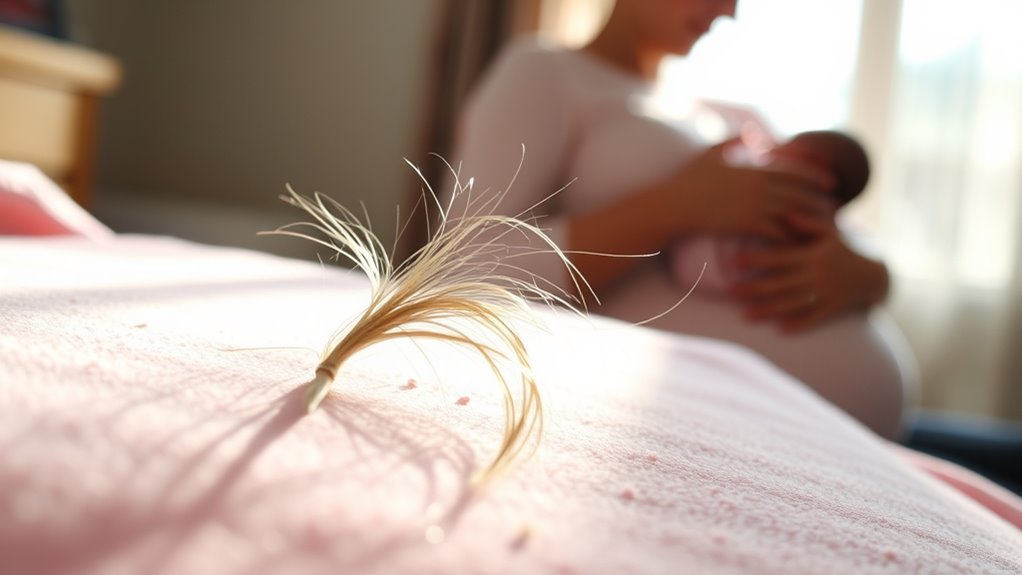
After you give birth, you might notice your hair starting to shed around three to four months postpartum due to hormonal shifts. The peak shedding usually happens between four to five months, leaving many new mothers worried about their locks. Fortunately, most women see their hair return to normal within six to fifteen months, often by their child’s first birthday. This emotional volatility experienced during the postpartum period can also impact overall well-being, making it important to seek support if needed. Additionally, maintaining a balanced diet that includes nutrient-dense foods can support overall health during this transitional time. Engaging in practices that promote relaxation, such as visualization techniques, can further help in managing stress levels during this period.
Initial Shedding Timeline
Once you’ve given birth, you might start noticing changes in your hair around three to four months postpartum. This is when hormonal levels begin to stabilize, leading to increased hair shedding. The initial shedding timeline shows that most women experience noticeable postpartum hair loss between four and five months postpartum.
| Time Postpartum | Shedding Phase | Hair Regrowth |
|---|---|---|
| 3-4 months | Initial shedding begins | N/A |
| 4-5 months | Peak of excessive shedding | N/A |
| 6-15 months | Regrowth expected | Stabilization by 1st birthday |
This excessive shedding phase can last from six to fifteen months and is a common condition, but regrowth is normal within that timeframe. It’s important to remember that during this period, you may encounter soulmate angel numbers that signify emotional growth and readiness for new connections.
Peak Shedding Period
When you reach the four to five-month mark postpartum, you may face an increase in hair shedding that can be alarming.
This peak shedding period often occurs due to a hormonal drop, prompting your hair follicles to enter the shedding phase known as telogen effluvium. Approximately 50% of new mothers experience noticeable postpartum hair loss during this time.
The changes in blood supply and hormone levels after giving birth can lead to this significant shedding.
However, it’s important to remember that hair regrowth typically starts within six to twelve months after the peak shedding period.
Rest assured, most women experience stabilization and recovery, returning to a fuller head of hair in the months that follow.
Long-Term Growth Expectations
As you navigate the months following childbirth, understanding what to expect regarding hair growth can ease concerns about postpartum shedding.
Postpartum hair loss typically begins around three to four months after delivery, coinciding with changing hormone levels. You might notice significant hair shedding peaking between four to five months postpartum, with excessive shedding lasting six to fifteen months.
Rest assured, normal growth cycles will eventually resume. By your child’s first birthday, many mothers often see a return to their pre-pregnancy hair density, although experiences vary.
As the shedding phase concludes, new hair growth may create shorter layers, often called “baby bangs.” Embrace this temporary hair loss, knowing it’s a natural part of your body’s recovery after pregnancy.
Factors Contributing to Postpartum Hair Loss
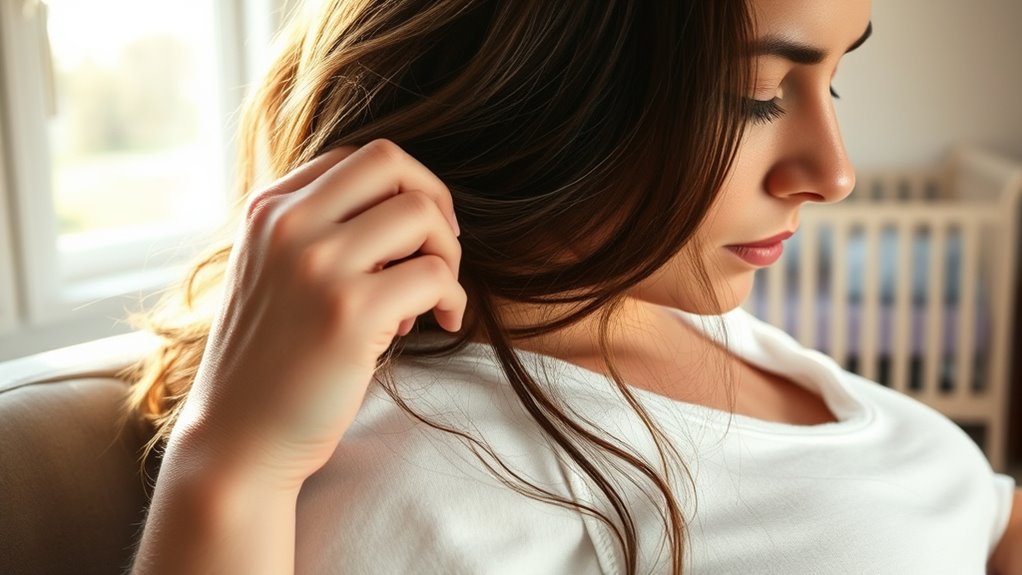
Postpartum hair loss can often feel overwhelming, primarily due to fluctuating hormone levels that occur after childbirth. The drop in estrogen levels leads to a condition called telogen effluvium, where hair shifts from the growth phase to shedding.
During pregnancy, higher estrogen levels prolong this growth phase, resulting in thicker hair, but postpartum changes trigger significant hair shedding. Emotional stress from childbirth can also amplify hair loss, adding to the anxiety of new motherhood.
Additionally, nutritional deficiencies—like low protein, iron, and essential vitamins—can compromise your hair health, making it more prone to shedding.
Finally, genetic factors can influence the severity and duration of postpartum hair loss, as individual hormonal levels and family history affect hair growth cycles.
Recognizing Symptoms of Hair Loss

How can you tell if you’re experiencing postpartum hair loss? Many new moms notice increased hair loss around four to five months postpartum. You might see more hair on your pillow, in the shower drain, or even on your clothes. Symptoms of postpartum hair loss often include significant shedding while brushing or washing your hair, leading to distress. Thinning hair along the hairline is also common, especially for those with longer hairstyles. Remember, this is a temporary condition affecting about 40% to 50% of new moms, and regrowth is expected as hormone levels stabilize.
| Symptoms | What to Look For | When to Expect It |
|---|---|---|
| Increased shedding | Hair on pillows and clothing | 4-5 months postpartum |
| Thinning hair | Noticeable loss at hairline | 4-5 months postpartum |
| Significant loose hair | Excessive loss during styling | 4-5 months postpartum |
The Temporary Nature of Shedding
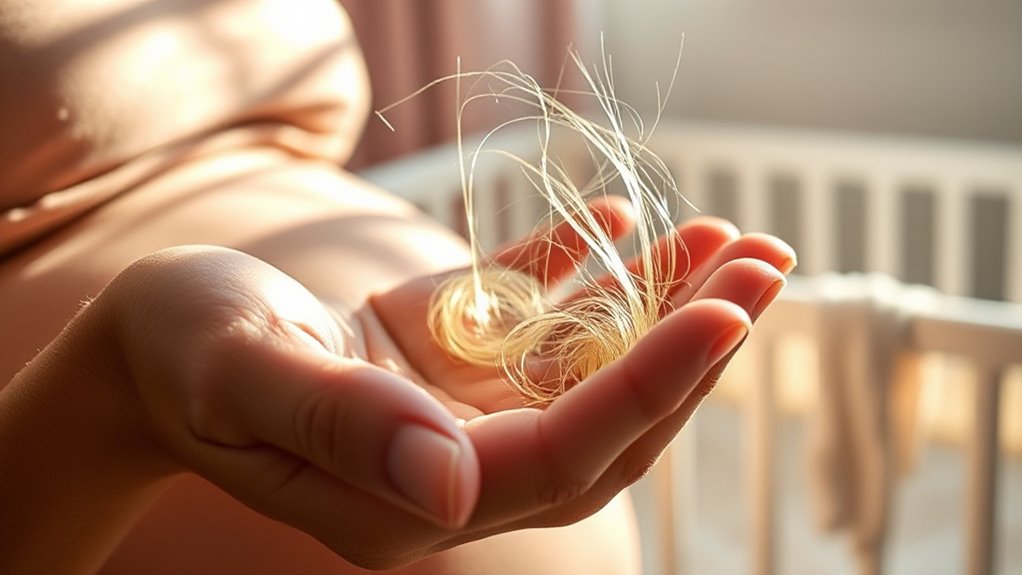
After giving birth, you might notice increased hair shedding due to hormonal changes that trigger your hair’s resting phase.
This process is a normal part of your body adjusting after pregnancy and usually peaks around four to five months postpartum.
Rest assured, your hair will likely return to its normal growth cycle within six to twelve months.
Hormonal Changes Explained
As your body adjusts to life after childbirth, the significant hormonal shifts can lead to unexpected hair loss, known as telogen effluvium.
After delivery, estrogen levels drop dramatically, causing many hair follicles to enter a resting phase. This shift disrupts the normal hair growth cycle, resulting in increased shedding during the postpartum period.
Typically, you’ll notice this shedding phase beginning three to four months after childbirth, with peak hair loss occurring around four to five months postpartum.
While it may feel alarming, remember that this is a temporary phase. Most people can expect their hair to return to its pre-pregnancy growth cycle within six to twelve months as hormone levels stabilize and hair growth resumes.
Normal Growth Cycle
Understanding the normal hair growth cycle can help you put postpartum shedding into perspective. Hair grows in three phases: anagen (growth), catagen (change), and telogen (shedding). After childbirth, decreased estrogen levels push more hair follicles into the shedding phase, leading to postpartum hair loss.
| Phase | Description |
|---|---|
| Anagen | Active growth phase |
| Catagen | Change phase |
| Telogen | Shedding phase |
This excessive shedding peaks around four to five months postpartum but is a temporary condition. Most women can expect hair regrowth within 6-12 months. Remember, your hair will return to its normal growth cycle, as this is a common condition that resolves itself.
Frequently Asked Questions
How to Stop Hair Falling Out Postpartum?
To stop hair from falling out postpartum, start by maintaining a balanced diet rich in protein, iron, and Vitamin C.
Use gentle, sulfate-free shampoos and conditioners to reduce breakage.
Incorporate scalp massages with natural oils to boost blood circulation.
Avoid tight hairstyles and excessive heat styling to prevent further stress on your hair.
Consulting a dermatologist about supplements or treatments can also help you manage shedding effectively during this time.
How Common Is Postpartum Hair Loss?
Postpartum hair loss is surprisingly common, affecting around 40% to 50% of new parents after childbirth.
You might notice it starting three to four months postpartum, peaking around four to five months.
While it can feel alarming, remember that most people experience hair regrowth by their child’s first birthday.
The severity and duration can vary, so don’t worry if your experience differs from others; it’s a natural part of the postpartum journey.
What Vitamin Deficiency Causes Postpartum Hair Loss?
Did you know that nearly 50% of new mothers experience some level of hair loss?
Vitamin D deficiency is a key factor contributing to this issue, as it’s essential for the hair growth cycle.
If you’re low on iron, it can worsen the situation by hindering oxygen supply to your follicles.
Don’t forget about biotin and zinc either; these nutrients are important for maintaining healthy hair during this changing period.
Does Hair Fall Out When You Stop Breastfeeding?
Yes, your hair can fall out when you stop breastfeeding.
This happens due to hormonal changes in your body, particularly a drop in estrogen levels, which triggers increased hair shedding.
You might notice this shedding around three to four months after weaning, as your body adjusts back to its pre-pregnancy hormonal state.
Don’t worry, though; this hair loss is usually temporary, and most women find their hair regrows within six to twelve months.
Conclusion
Postpartum hair loss can be alarming, but it’s usually a temporary phase. You might notice clumps of hair in your brush, like Sarah, a new mom who felt overwhelmed when her hair thinned dramatically at three months postpartum. Understanding that hormonal shifts are at play can ease your worries. Remember, with time and care, your hair will likely return to its pre-pregnancy fullness. Embrace this journey, and give yourself grace as your body adjusts.
